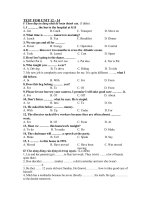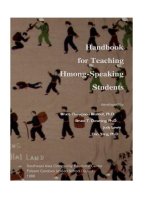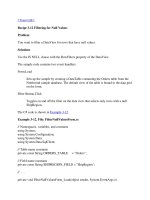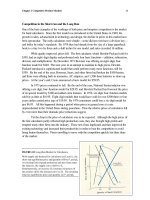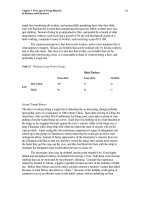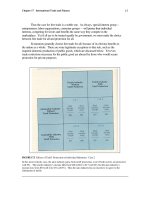Tài liệu Test for SAT 3 pptx
Bạn đang xem bản rút gọn của tài liệu. Xem và tải ngay bản đầy đủ của tài liệu tại đây (94.69 KB, 8 trang )
SAT Practice Test 3
VERBAL
1 – Until his defeat by the newcomer, the veteran boxer won most of his bouts by
knockouts and had achieved an ---- series of wins.
(A)inconsequential
(B) exaggerated
(C) able-bodied
(D)unbroken
(E) observable
2 – Bird watching requires ---- patience as well as keen powers of ----, since one must sit
still for hours and remain alert to the slightest sound or motion.
(A)extreme..persuasion
(B) skilled..concentration
(C) cheerful..reasoning
(D)silent..trust
(E) limitless..observation
3 – Photographer Edward Weston’s work was akin to alchemy, his camera lens magically
transforming ----, everyday items such as vegetables into objects of ---- beauty.
(A)inexpensive..tawdry
(B) mundane..resplendent
(C) small..enormous
(D)decorative..functional
(E) artificial..natural
4 – The spokesperson for the group said that the issues raised by the controversy have ----
that go far beyond the matter presently under discussion.
(A)expectations
(B) ramifications
(C) proponents
(D)inferences
(E) critics
5 – Prime Minister Neville Chamberlain of Great Britain adopted a ---- approach to
Hitler, even accepting Germany’s annexation of Austria.
For more material and information, please visit Tai Lieu Du Hoc at www.tailieuduhoc.org
(A)hasty
(B) precarious
(C) haughty
(D)conciliatory
(E) dependent
6 – Many who were ---- enough to witness Sir Michael Redgrave’s performance in the
role of Uncle Vanya assert that it was the ---- of his career.
(A)close..scourge
(B) astute..encore
(C) fortunate..pinnacle
(D)hapless..height
(E) lucky..nadir
7 – Whenever she felt tired after work, a brisk walk along the beach amid the ---- sea air
never failed to ---- her fatigue and leave her re-energized.
(A) humid..hasten
(B) salty..exacerbate
(C) bracing..alleviate
(D) damp..reprove
(E) chilly..aggravate
8 – “Old Nick” is one of several ---- people use when they want to refer indirectly to the
Devil.
(A)euphemisms
(B) banalities
(C) arguments
(D)apostrophes
(E) eulogies
9 – Because its bookkeepers altered some figures and completely fabricated others, the
company’s financial records were entirely ----.
(A)cursory
(B) disseminated
(C) singular
(D)concealed
(E) spurious
For more material and information, please visit Tai Lieu Du Hoc at www.tailieuduhoc.org
Choose the lettered pair of words that is related in the same way as the pair in capital
letters.
10 – ANCHOR:BOAT::
(A) sink:ship
(B) launch:pier
(C) propel:rocket
(D) tether:horse
(E) waddle:duck
11 – COLLABORATE:WORK::
(A) question:borrow
(B) clot:bleed
(C) cohabit:live
(D) synchronize:watch
(E) cooperate:please
12 – APRON:CLOTHES
(A) parasol:sun
(B) gloves:cold
(C) socks:shoes
(D) jacket:hood
(E) helmet:head
13 – PREACHER:PULPIT
(A) teacher:student
(B) conductor:podium
(C) artist:canvas
(D) performer:gallery
(E) athlete:obstacle
14 – ADULATION:PRAISE::
(A) loathing:dislike
(B) disdain:contempt
(C) scholarship:eloquence
(D) sympathy:emotion
(E) pleasure:hedonism
15 – ANALGESIC:PAIN::
(A) purgative:purity
(B) emollient:dryness
For more material and information, please visit Tai Lieu Du Hoc at www.tailieuduhoc.org
(C) humidifier:ventilation
(D) operation:hospital
(E) vaccine:injection
The following two passages discuss some notable developments and issues in related
areas of medical research.
Passage 1
Surgeons can perform phenomenal feats. They
replace clogged coronary arteries with blood vessels
from the leg. They reconnect capillaries, tendons,
and nerves to reattach severed fingers. They even
refashion parts of intestines to create new bladders. Line (5)
But surgeons find it difficult to reconstruct
complicated bones like the jawbone or those of the
inner ear. And only rarely can they replace large
bones lost to disease or injury.
The challenge stems from the nature of bones. (10)
Unlike other types of tissue, bones with one normal
shape cannot be reworked into other shapes. Nor can
doctors move large bones from one part of the body
to another without severely disabling a person.
Existing treatments for bone defects are all short- (15)
term and limited. Surgeons can replace some
diseased joints with plastic or metal implants, but
artificial hips or knees steadily loosen and must be
reconstructed every few years.
Fortunately, surgeons are beginning to overcome (20)
these obstacles by creating bone substitutes from, of
all things, muscle. The idea of making bones from
muscle is not all that strange. Muscle, bone, fat,
blood vessels, and bone marrow all develop in human
embryos from the same loosely organized tissue. (25)
In 1987 scientists isolated a bone-inducing protein
called osteogenin from cows. Osteogenin can make
undifferentiated human tissue produce cartilage and
bone. But few surgeons have used osteogenin because
it is hard to control. If sprinkled directly onto a (30)
defect, for instance, the entire area might stiffen to
bone if a tiny bit fell on surrounding blood vessels
and nerves.
More recently, plastic surgeons have circum-
vented that snag by prefabricating bones away from (35)
the immediate site of a defect. Flaps of animal thigh
For more material and information, please visit Tai Lieu Du Hoc at www.tailieuduhoc.org
muscles are taken and placed in osteogenin-coated
silicone rubber molds of the desired shape. The
molds are implanted in the same animal’s abdomen
to provide a suitable biologic environment for (40)
transforming muscle into bone. Within weeks, the
molds yield tiny, perfectly detailed bone segments.
So far, surgeons have made bones from muscles in
small animals, but have not yet tried the process in
humans. For one thing, osteogenin is available only (45)
in small amounts. Secondly, the safety and
effectiveness of the process must first be tested on
larger animals.
Passage 2
We have entered a new era in medicine. In
scarcely more than a generation, artificial organs (50)
have evolved from temporary substitutes to long-
functioning devices. Millions of people live with
cardiac pacemakers, arterial grafts, hip-joint
prostheses, middle-ear implants, and intraocular
lenses. Eventually, artificial organs will allow (55)
ordinary, healthy people to live longer – or, more
appropriately, to die young at a ripe age. So far,
though, even the best substitutes lag far behind their
natural counterparts. But the obstacles to better
implants are not purely technical. Because such (60)
devices require human testing, their development
poses a challenge to our cultural and ethical values.
Although many patients volunteer for tests of
unproven medical devices, such altruism – and the
medical progress it engenders – is hampered by (65)
medical ethicists and others who call for more
restrictions on human testing. While people favoring
restrictions are well-intentioned, their standards are
inappropriate.
The only way to gain the information needed for (70)
refining artificial organs is through experiments on
people. Research using animals will not suffice. The
mechanics of bone joints, for example, differs
markedly from species to species. The replacement
of wrists, knees, and finger joints poses complex (75)
engineering problems because of the heavy
mechanical loads involved and the range of motion
required. Since there is no generally accepted large-
For more material and information, please visit Tai Lieu Du Hoc at www.tailieuduhoc.org
